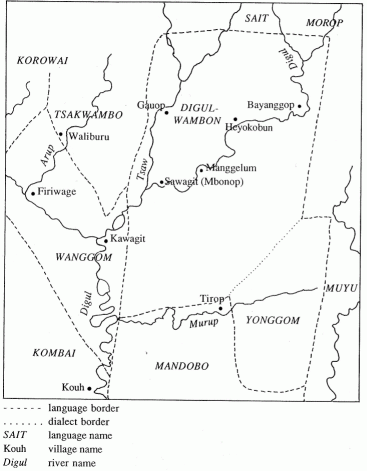Yonggom Wambon
Language Background
Yonggom Wambon, also referred to as South Wambon, is a Ndumut language spoken by around 1000 people in the Upper-Murup area (see map). Drabbe described Yonggom as spoken by the people in the village of Waniktit, and published a Yonggom grammar with word list and transcribed texts in 1959.

[geographical location of Ndumut languages]
Some Language Facts
In its verbal structure, Yonggom Wambon is very similar to Digul Wambon. A fully finite verb consists of a verb stem + mood marker + person-number marker + tense marker. Less finite forms exist in Yonggom Wambon as they do in other Awyu-Ndumut languages, namely as (a) verb stem + mood + person-number, or as (b) a bare verb stem. A semi-finite form with realis marker -ken looks as follows:

As these forms only have a realis marker and no tense marker, they can be interpreted as either occurring in the present or in the past. In order to be interpreted as occurring in the future, the verb would have to be marked with an irrealis marker.
Mood
Yonggom Wambon has two realis markers, whereas irrealis mood is always ø-marked. The two realis markers are -t and -ken. These two forms can be used interchangeably it seems; Drabbe notes that “in ‘t algemeen kunnen we over het gebruik der -t vormen hetzelfde zeggen als over dat der -ken vormen” (Drabbe 1959:129) (“in general, the same can be said about -t forms that can be said about -ken forms”). Both -t and -ken forms may occur anywhere within the sentence without changing their meaning. In texts, -t forms do seem more frequent than -ken forms. Yonggom Wambon -ken has various allomorphs: -gen after /m/ and vowels, -ŋgen after /n/, -kin after forms ending in –in and –kon when following a verb stem that ends in /o/. The -t becomes an /r/ in between vowels in Yonggom Wambon, and so the realis marker -t is often realized as -r.
Mood describes a speaker’s attitude towards a situation, while tense locates a particular situation in time. The Yonggom Wambon verb system, and the Ndumut verb system overall, appears to be ‘mood-driven’. Foley and Van Valin (1984) note that mood is a more basic category than tense and that “the likelihood of the proposition along the realis-irrealis dimension is first established, and then the temporal orientation of this modified proposition is established with respect to the time of the speech act” (Foley and Van Valin 1984:216) which means that a verb form is first specified for what mood it is in, and then for tense. This is certainly true in Yonggom Wambon, where mood is always marked directly after the verb stem, where the tense marker never precedes the mood marker and where tense is often not marked on the verb while mood is.
